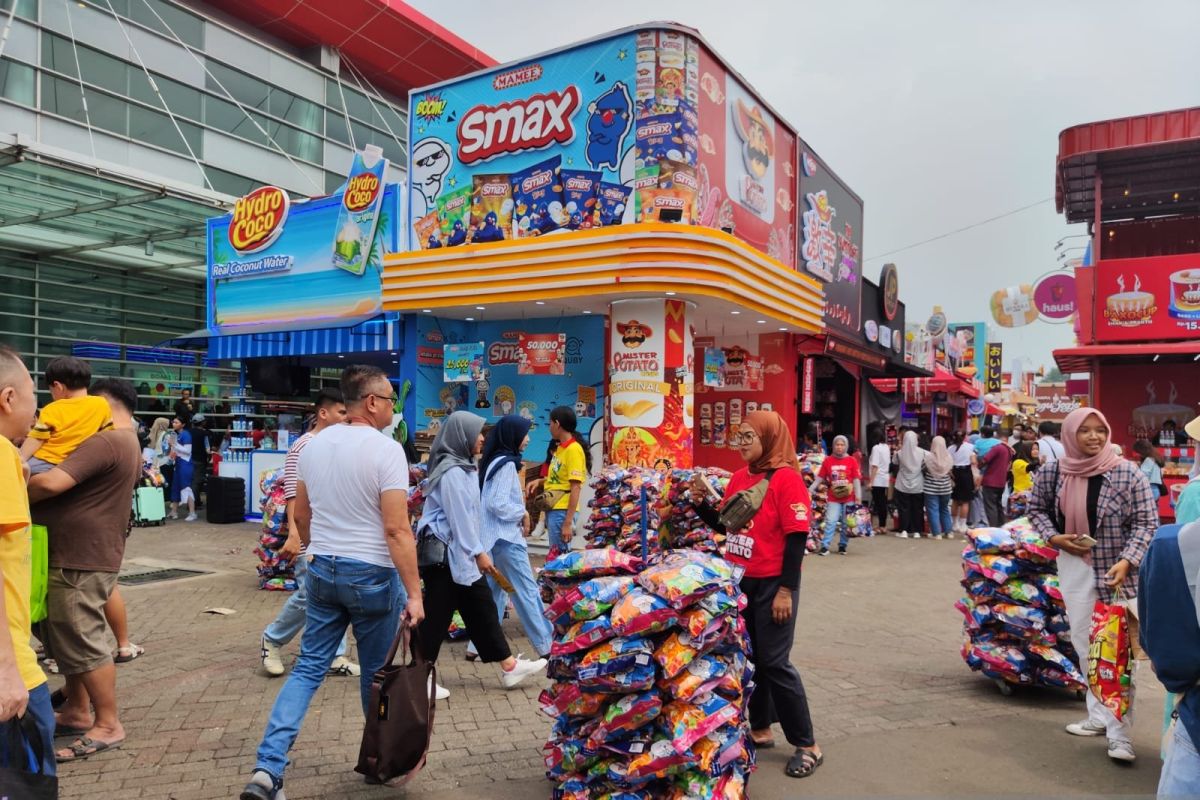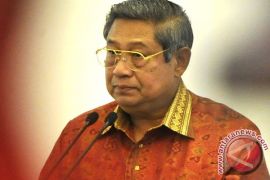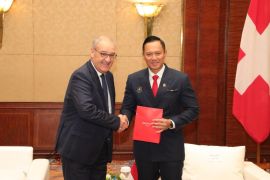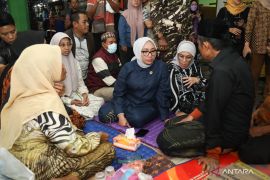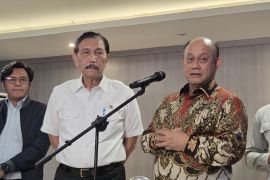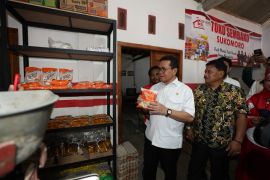The annual event, which has been held for nearly three generations since 1968, has successfully transformed its image from a small people's event to the largest and most comprehensive exhibition in Southeast Asia.
Formerly known as the Djakarta Fair, it is awaited every year by Jakarta's residents.
Former Jakarta governor Ali Sadikin, who served the city from 1966 to 1977, at that time inaugurated the Djakarta Fair at the Gambir Market that showcased industrial products.
The Gambir Market has existed since 1906.
During the period from mid-August to mid-September of 1906, it was a place to exhibit various products, as part of the events to celebrate the birthday of Queen Wilhelmina of the Netherlands.
The opening and closing of Gambir Market were always enlivened by fireworks parties.
Over time, the popularity of Gambir Market dimmed, until Governor Sadikin came up with an idea to re-hold the city's major annual event though this time to mark Jakarta's birthday.
With the initiative, the Djakarta Fair was held for the first time from June 5 to July 20, 1968, in the National Monument (Monas) area.
The head of state at that time, President Soeharto, inaugurated the Djakarta Fair by releasing pigeons. Although it was held for the first time, it was considered successful, as it was able to attract 1.4 million visitors.
One of the residents of Kebon Sirih, Jakarta, Henni, now 62, recounted that she often visited the Djakarta Fair since she was a child.
At that time, her house was still located in the Monas area, close to Taman Ria, Jakarta's nightlife center in the past, as it offered fun rides, such as carousels, Ferris wheel, roller coasters, and the Wheel of Death, or locally called as the "tong setan."
Henni, who was still in elementary school at the time, opened up to ANTARA about her memories of going to the Djakarta Fair with her mother and sister.
The sparkling night lights and the myriad food and beverage outlets have indeed been the fair's mainstay for a long time.
In addition to the F&B outlets, there were merchants of household products and also exhibition booths from several friendly countries' embassies that displayed their art and culture, unique cuisines, and souvenirs.
"I remember that there used to be embassies introducing the culture of their countries, such as Japan, Russia, and Pakistan. My mother once bought a rosary made from Pakistan," Henni remarked.
Judi Kim and "American" donuts
Out of the various outlets that competitively offered their products, Henni recalled an area that was never empty of spectators, whether they were children or the elderly.
That area was where the game of "Judi Kim" was held. The game is now extinct. However, for Henni, it was like just yesterday night when she saw the level of enthusiasm of the players of Judi Kim.
According to Zeffry J. Alkatiri through his book "Pasar Gambir, Komik Cina, dan Es Shanghai" (2010), the Judi Kim game was accompanied by a band that plays Minangnese pop songs.
To win the game, the player must cross out numbers on a small piece of paper. The numbers are called by the singer with witty sayings, for instance, the number 33 is called three marriages, while the number 51 is called a five carrying a stick.
A person, who manages to cross out one horizontal line of numbers, must immediately raise his or her hand and the music stops right away.
Meanwhile, a booth that has always been present at the Jakarta Fair is called "American Donat (donuts)".
Despite an "American" word being embedded in the brand, it is a local micro, small, and medium enterprise (MSME). The donuts are served with various toppings, such as nuts, meses or chocolate granules, cheese, and powdered sugar.
The Jakarta Fair, which was earlier located in the Monas Area, had to move to the Jakarta International Expo in Kemayoran in 1992 due to the increasing number of visitors.
Now electric cars
The Jakarta Fair is an inseparable part of the Jakarta City anniversary, which is commemorated every June 22.
During the 70s, the Djakarta Fair was replete with exhibitions by television companies, though now, the visitors currently throng the electric car showcases at the fair.
This seems to be in line with the theme "Jakarta Fair Supports National Economic Growth to Compete in the World Market" of the Jakarta Fair 2024.
This year's Jakarta Fair, held from June 12 to July 14, 2024, also has the sub-theme of "Bolster Innovation, Industrialization, Maximum Creativity."
Jakarta International Expo Kemayoran Marketing Director Ralph Scheneumann stated that Hall A of the JI Expo Building hosts automotive companies, with most of them showcasing electric vehicles.
He remarked that at least 40 electric vehicle companies, both motorcycles and cars, are participating in the exhibition.
The Jakarta Fair has consistently supported Jakarta's economic growth. Despite losing its capital city status, Jakarta is still the province with the largest contribution to the national economy.
The Jakarta Fair Kemayoran Exhibition was held for the 55th time in 2024.
The annual event, which has been held for nearly three generations since 1968, has successfully transformed its image from a small people's event to the largest and most comprehensive exhibition in Southeast Asia.
Formerly known as the Djakarta Fair, it is awaited every year by Jakarta's residents.
Former Jakarta governor Ali Sadikin, who served the city from 1966 to 1977, at that time inaugurated the Djakarta Fair at the Gambir Market that showcased industrial products.
The Gambir Market has existed since 1906.
During the period from mid-August to mid-September of 1906, it was a place to exhibit various products, as part of the events to celebrate the birthday of Queen Wilhelmina of the Netherlands.
The opening and closing of Gambir Market were always enlivened by fireworks parties.
Over time, the popularity of Gambir Market dimmed, until Governor Sadikin came up with an idea to re-hold the city's major annual event though this time to mark Jakarta's birthday.
With the initiative, the Djakarta Fair was held for the first time from June 5 to July 20, 1968, in the National Monument (Monas) area.
The head of state at that time, President Soeharto, inaugurated the Djakarta Fair by releasing pigeons. Although it was held for the first time, it was considered successful, as it was able to attract 1.4 million visitors.
One of the residents of Kebon Sirih, Jakarta, Henni, now 62, recounted that she often visited the Djakarta Fair since she was a child.
At that time, her house was still located in the Monas area, close to Taman Ria, Jakarta's nightlife center in the past, as it offered fun rides, such as carousels, Ferris wheel, roller coasters, and the Wheel of Death, or locally called as the "tong setan."
Henni, who was still in elementary school at the time, opened up to ANTARA about her memories of going to the Djakarta Fair with her mother and sister.
The sparkling night lights and the myriad food and beverage outlets have indeed been the fair's mainstay for a long time.
In addition to the F&B outlets, there were merchants of household products and also exhibition booths from several friendly countries' embassies that displayed their art and culture, unique cuisines, and souvenirs.
"I remember that there used to be embassies introducing the culture of their countries, such as Japan, Russia, and Pakistan. My mother once bought a rosary made from Pakistan," Henni remarked.
Judi Kim and "American" donuts
Out of the various outlets that competitively offered their products, Henni recalled an area that was never empty of spectators, whether they were children or the elderly.
That area was where the game of "Judi Kim" was held. The game is now extinct. However, for Henni, it was like just yesterday night when she saw the level of enthusiasm of the players of Judi Kim.
According to Zeffry J. Alkatiri through his book "Pasar Gambir, Komik Cina, dan Es Shanghai" (2010), the Judi Kim game was accompanied by a band that plays Minangnese pop songs.
To win the game, the player must cross out numbers on a small piece of paper. The numbers are called by the singer with witty sayings, for instance, the number 33 is called three marriages, while the number 51 is called a five carrying a stick.
A person, who manages to cross out one horizontal line of numbers, must immediately raise his or her hand and the music stops right away.
Meanwhile, a booth that has always been present at the Jakarta Fair is called "American Donat (donuts)".
Despite an "American" word being embedded in the brand, it is a local micro, small, and medium enterprise (MSME). The donuts are served with various toppings, such as nuts, meses or chocolate granules, cheese, and powdered sugar.
The Jakarta Fair, which was earlier located in the Monas Area, had to move to the Jakarta International Expo in Kemayoran since 1992 due to the increasing number of visitors.
Now electric cars
The Jakarta Fair is an inseparable part of the Jakarta City anniversary, which is commemorated every June 22.
During the 70s, the Djakarta Fair was replete with exhibitions by television companies, though now, the visitors currently throng the electric car showcases at the fair.
This seems to be in line with the theme "Jakarta Fair Supports National Economic Growth to Compete in the World Market" of the Jakarta Fair 2024.
This year's Jakarta Fair, held from June 12 to July 14, 2024, also has the sub-theme of "Bolster Innovation, Industrialization, Maximum Creativity."
Jakarta International Expo Kemayoran Marketing Director Ralph Scheneumann stated that Hall A of the JI Expo Building hosts automotive companies, with most of them showcasing electric vehicles.
He remarked that at least 40 electric vehicle companies, both motorcycles and cars, are participating in the exhibition.
The Jakarta Fair has consistently supported Jakarta's economic growth. Despite losing its capital city status, Jakarta is still the province with the largest contribution to the national economy.
Related news: Jakarta Fair expected to present opportunities for network exchange
Related news: Indonesian trade exhibition draws US$73 M in transactions from Egypt
Translator: Mentari G, Kenzu
Editor: Tia Mutiasari
Copyright © ANTARA 2024
